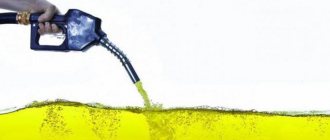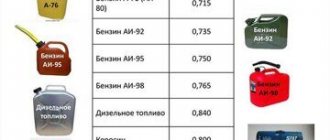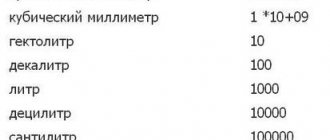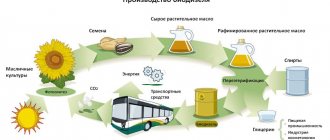Anyone who studied well at school and understood physics knows that the volume of any liquid substance can depend on two parameters - mass and density. If these quantities are known, then it can be calculated. Knowing the density, we can determine how many liters of diesel fuel are in 1 ton. However, it is worth noting that the density of diesel fuel cannot be standard - it varies depending on the ambient temperature. Therefore, in winter there will be fewer liters of fuel in one ton, and more in summer.
Density of different types of diesel fuel
All diesel fuel is divided into different types and is not standard. There are at least three types: summer, winter, arctic fuel. The density is different, and in order to calculate how many liters of diesel fuel are in 1 ton, we need to know this value.
So, summer diesel fuel has a density of 860 kg/m3. This diesel fuel is distinguished by its operating temperature range. At 10 degrees above zero, this fuel may begin to solidify. The temperature at which a flash is possible is 45 degrees above zero. It is usually sold in hot countries.
Winter diesel fuel has a density of 840 kg/m3. It does not harden at temperatures not lower than -35 degrees. Therefore, this fuel is effective in winter. Ignition is possible at 40 degrees Celsius.
There is also Arctic diesel fuel, which is rarely found at gas stations in the city. Its density is 830 kg/m3. It can ignite at 35 degrees Celsius.
If this product is sold in large volumes, the calculation is made in tons, not in liters. This is because liquid can contract or expand at low and high temperatures, respectively. Consequently, the volume will increase or decrease, but the mass will remain constant. Of course, you can buy it in liters, but then there may be a high error for better or worse for the buyer or seller.
Petroleum product unit calculator
The calculator is designed to calculate the conversion of liters to tons, or, knowing the price per ton, calculate the price per liter. Also perform reverse calculations. When you select a product, the density is set by default. If you manually enter the density, the calculator will give more accurate readings. Average density indicated.
Calculating the density, mass and volume of petroleum products is not very difficult, but calculating everything manually using formulas is still a significant waste of time. To quickly convert from liters to tons and make other calculations related to petroleum products, it is most convenient to use a ready-made online calculator.
How to use the petroleum unit calculator
The program is designed to quickly convert liters of petroleum products into tons, as well as to calculate the cost of a liter based on prices per ton. Naturally, it is also possible to carry out calculations in reverse order.
The main thing to consider when working with the calculator is the density of the petroleum product for which the calculation is being performed. For example, if you need to convert a liter of gasoline to tons, the user’s actions will be as follows:
- In the first form provided, indicate the type of petroleum product. Depending on the user's selection, the corresponding density of the substance will be displayed.
- In the second form, specify the volume or mass of the substance (the second value will be determined automatically based on the previously specified density of the liquid).
- In the third form, indicate the cost of a liter or ton of petroleum product, after which the program will calculate the second value.
For each of the basic types of petroleum products, standard density data have been established. In practice, the values may differ depending on the specific physical characteristics of the substance. The page with the calculator provides reference density values for various types of petroleum products at a substance temperature of 20 degrees Celsius.
Calculation example
Let's assume that it is necessary to convert 100 liters of diesel fuel into tons, and then calculate the price. Actions with the petroleum products calculator will be as follows:
- Choose summer or winter diesel fuel. For summer, the program will automatically set the value to 0.835 grams per cubic centimeter.
- Indicate the volume - 100 liters, and in the next column it will be indicated that by weight it is 0.0835 tons.
- Indicate the price per liter - for example, 45 rubles. The calculator will show how much a ton of summer diesel fuel will cost – 53,892.22 rubles.
Based on the data obtained, it will be easy to simply calculate how much you need to pay when purchasing fuel in a certain volume.
How many liters of diesel fuel are in 1 ton?
Taking into account the known density of different types of diesel fuel, you can easily calculate how many liters a ton contains. So, summer fuel has a density of 860 kg/m3. That is, one thousand liters contains 860 kg. This means that 1000 kg of summer diesel fuel will have a volume of 1162.8 liters. This is exactly the container needed to fill one ton of fuel.
As for winter diesel fuel, its density is 840 kg/m3. Therefore, 1000 liters contain 840 kg. One ton of such fuel will have a volume of 1190.5 liters. As for Arctic diesel fuel, one ton of it will fit in a container with a volume of 1204 liters.
Knowing the density, it is easy to calculate these parameters. Now you know how many liters of diesel fuel are in 1 ton. Remember that this is not a constant value and changes depending on the temperature.
Specific heat of combustion of some combustible materials
A table is provided of the specific heat of combustion of some combustible materials (building materials, wood, paper, plastic, straw, rubber, etc.). Materials with high heat release during combustion should be noted. Such materials include: rubber of various types, expanded polystyrene (foam), polypropylene and polyethylene. Specific heat of combustion of some combustible materials
| Fuel | Specific heat of combustion, MJ/kg |
| Paper | 17,6 |
| Leatherette | 21,5 |
| Wood (bars with 14% moisture content) | 13,8 |
| Wood in stacks | 16,6 |
| Oak wood | 19,9 |
| Spruce wood | 20,3 |
| Wood green | 6,3 |
| Pine wood | 20,9 |
| Capron | 31,1 |
| Carbolite products | 26,9 |
| Cardboard | 16,5 |
| Styrene butadiene rubber SKS-30AR | 43,9 |
| Natural rubber | 44,8 |
| Synthetic rubber | 40,2 |
| Rubber SKS | 43,9 |
| Chloroprene rubber | 28 |
| Polyvinyl chloride linoleum | 14,3 |
| Double-layer polyvinyl chloride linoleum | 17,9 |
| Polyvinyl chloride linoleum on a felt basis | 16,6 |
| Warm-based polyvinyl chloride linoleum | 17,6 |
| Fabric-based polyvinyl chloride linoleum | 20,3 |
| Rubber linoleum (Relin) | 27,2 |
| Paraffin paraffin | 11,2 |
| Polystyrene foam PVC-1 | 19,5 |
| Foam plastic FS-7 | 24,4 |
| Foam plastic FF | 31,4 |
| Expanded polystyrene PSB-S | 41,6 |
| Polyurethane foam | 24,3 |
| Fiberboard | 20,9 |
| Polyvinyl chloride (PVC) | 20,7 |
| Polycarbonate | 31 |
| Polypropylene | 45,7 |
| Polystyrene | 39 |
| High pressure polyethylene | 47 |
| Low-pressure polyethylene | 46,7 |
| Rubber | 33,5 |
| Ruberoid | 29,5 |
| Channel soot | 28,3 |
| Hay | 16,7 |
| Straw | 17 |
| Organic glass (plexiglass) | 27,7 |
| Textolite | 20,9 |
| Tol | 16 |
| TNT | 15 |
| Cotton | 17,5 |
| Cellulose | 16,4 |
| Wool and wool fibers | 23,1 |
- Abryutin A. A. et al. Thermal calculation of boilers. Normative method.
- GOST 147-2013 Solid mineral fuel. Determination of the higher calorific value and calculation of the lower calorific value.
- GOST 21261-91 Petroleum products. Method for determining the higher calorific value and calculating the lower calorific value.
- GOST 22667-82 Natural flammable gases. Calculation method for determining the calorific value, relative density and Wobbe number.
- GOST 31369-2008 Natural gas. Calculation of calorific value, density, relative density and Wobbe number based on component composition.
- Zemsky G. T. Flammable properties of inorganic and organic materials: reference book M.: VNIIPO, 2022 - 970 p.
Conversion of diesel fuel: liters to tons
In order to recalculate diesel fuel, you need to apply the following formula:
V = M/p.
This formula is for determining volume. It follows from this that the mass will be equal to:
M = V * p.
In this formula:
- V – volume (liters);
- M – mass (tons or kilograms);
- p – density.
The density for different types of diesel fuel is already indicated above. It must be substituted for the p value. With two known quantities, we can easily calculate how many liters are in 1 ton of diesel fuel, or vice versa.
We also note that the Ministry of Industry and Energy of the Russian Federation averaged the density of diesel fuel for accurate recalculation. It is 0.769 kg/liter. It must be used for recalculation.
What does the current fuel density depend on?
The current density of diesel fuel depends on its brand and temperature. You can find out its density at a temperature of 15 or 20 degrees Celsius in the quality certificate.
The higher the temperature of the oil product, the less 1 liter will weigh, and the volume of a kilogram of fuel will increase.
When converting units of measurement, the formulas are used: m = p * V and V = m / p.
To check whether the density of diesel fuel corresponds to the data specified in the quality passport, you need to take a liter of diesel fuel, weigh it and place it in the temperature environment in which the manufacturer conducted density tests: +150C or +200C. The exact weight of the fuel must be divided by its volume. We get the current density and compare it with the passport data.
Why is this even needed?
Why do people need to know how many liters of diesel fuel are in 1 ton? Everything is simple when it comes to buying small volumes of diesel fuel: we arrived at the gas station, filled the tank full and drove on. However, not all so simple. Companies that purchase large volumes of fuel calculate in other units of measurement - tons or kilograms. And this is completely logical, because the volume of diesel fuel is not a constant quantity and can change. For example, a person will buy 500 liters of fuel in the summer when it’s hot, but in the fall when it gets cold it turns out that there are only 450 liters left in the tank. It turns out that he overpaid the seller 50 liters. And if payment was made for kilograms or tons, then nothing like this would happen, and no one would be at a loss, since the weight remains unchanged.
Therefore, all major sales/purchases of this product are carried out taking into account the weight, and not the volume of diesel fuel, since diesel fuel in tons and liters is not the same thing.
How to convert motor oil to kilograms and liters?
To accurately determine the weight of one liter of oil, or vice versa, to convert kg to liters, you need to know the passport data of the density of the product being tested. When converting units of measurement, the formulas are used: m = p * V and V = m / p.
So on average: 1 kg of oil is equal to 1.09 liters; A 4-liter canister will weigh 3.5 kg, and if you convert from liters how much a 200-liter barrel weighs, you get 180 kilograms.
Oil conversion table from liters to kg
| Conversion of volume and weight of motor oils | ||
| SAE Viscosity | Kilogram in 1 lira | Liters per 1 kg |
| 0w40 | 0,85 | 1,17 |
| 5w30 | 0,86 | 1,16 |
| 5w40 | 0,87 | 1,15 |
| 10w30 | 0,87 | 1,15 |
| 10w40 | 0,86 | 1,16 |
| 15w40 | 0,91 | 1,10 |
| 20w50 | 0,88 | 1,14 |
The denser the oil, the less dependent the weight and volume on temperature conditions.
Algorithm for working with a calculator
The converter allows you to find out the weight of 1 liter of petroleum product automatically. For individual calculations you need to follow a few simple steps:
- enter weight (volume) indicators in a special window (values are indicated in l, kg, tons);
- mark the type of viscosity (thickness will be indicated on average at +20°C) or enter the density value (in kg/l, kg/m3), according to the data specified by the manufacturer;
- at a temperature lower or higher than +20°C, you should enter the data in a special window, select the difference using the arrows;
- choose for a fresh or used type of product, a calculation is carried out, the converter automatically takes into account the density of the fresh product, however, during operation the characteristics change, so it is necessary to take into account the correction; to convert other types of fuel and lubricants, the value is left at default.
After entering all the characteristics into the appropriate fields, the result of the conversion from volume to mass (or vice versa) becomes visible automatically.
Physical characteristics of diesel
Diesel fuel refers to products obtained after distillation of oil at special enterprises (refineries). The quality and composition of the finished liquid must meet strict standards. The density value is a parameter that is involved in determining the productive performance of the fuel under various conditions.
Experts know that this parameter is not constant and depends on external factors, the main one of which is the ambient temperature. A rise in the thermometer stimulates a decrease in density, and the reverse process increases the specific gravity of diesel fuel.
To obtain a specific value, a measuring device is used - a hydrometer. During the measurement process, the unit must be lowered into a container with diesel fuel. To carry out measurements in different liquids, different types of hydrometers are used. Measurements in petroleum products are carried out using models AN, ANT-1 or ANT-2.
The hydrometer is made in the form of a glass tube, inside of which there is a graduated vertical scale. A greater degree of immersion demonstrates a lower density and vice versa.
We recommend: What kind of motor oil should you pour into your engine: synthetic or semi-synthetic?
The increased specific gravity of the liquid is a consequence of the fact that it contains heavy hydrocarbon fractions. Because of this, the high-quality operation of the internal combustion engine may decrease, because the evaporation of the liquid deteriorates and its good atomization by the nozzles is not ensured. An additional negative from the presence of a large number of heavy particles is that soot and various deposits form on the working surfaces.










